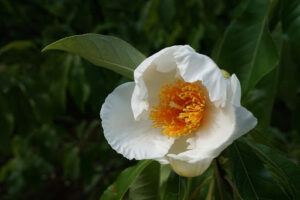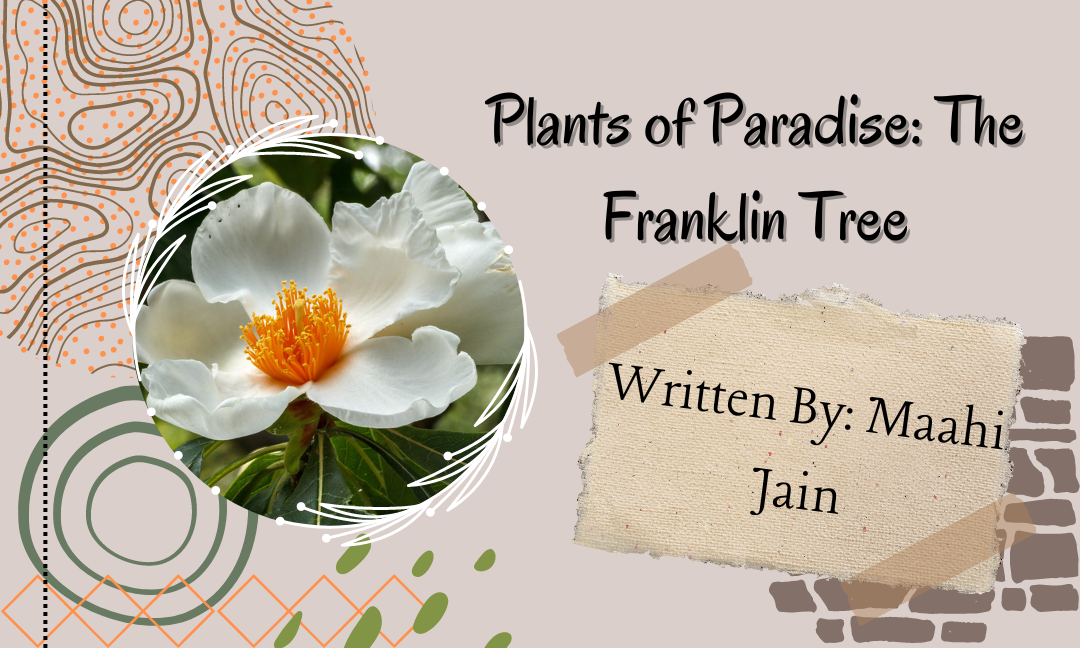Written by: Maahi Jain
Edited by: Julia Georgescu
Designed by: Maahi Jain
Published by: Tvisha Lakhani
The Franklin tree, in light of its extinction in the early 19th century, is—much like the chocolate cosmos— uncommonly heard of. It’s understandable considering it’s one of the rarest plants in the world. This species doesn’t exist outside of cultivation, however.
The Franklinia Alatamaha is being kept alive through means of propagation (breeding cultivars using the parent species). The plant was discovered by a pair of botanists, father and son. The earliest mention of the Franklin tree was in 1765, found in a journal by John Bartram where he came across “several very curious shrubs”. This was documented during his trip to what used to be the Southeastern part of the British colony of Georgia. He concluded the flower to be a part of the species of Gordonia lasianthus, however, some key differences could be noted between the two—the flowers belonging to the unknown species were much larger and much more aromatic. These “shrubs” were found along the banks of the Altamaha River, never being observed growing anywhere other than near the river. On a return trip to Georgia in 1773, William Bartram collected samples which he brought back to Philadelphia, successfully growing them. Every Franklin tree currently grown comes from the original seeds Bartram had procured. The plant is named after a renowned historical figure, and also a close friend of the Bartrams, Benjamin Franklin. The last confirmed sighting of the Franklin tree was by John Lyon—a well-known botanist at the time—in 1803 and has remained extinct ever since.
The Franklin tree is a deciduous tree, part of the Theaceae family, the tea family. It shares similar characteristics with other plant species like the camellia. The Franklin tree is best described as a white, fragrant flower—often associated with the smell of honeysuckle or orange blossoms. Their petals are cup-shaped, holding a cluster of orange-yellow stamens. They sport dark green oblong, and glossy leaves. Approaching autumn, these leaves turn various shades of orange, red, and purple.

The Franklin tree is very particular when it comes to maintenance, requiring extremely precise amounts of soil, water, and sunlight exposure. When placing them under ideal conditions and providing proper care, these trees can grow up to 20 feet tall, with a spread going as far as 15 feet. They thrive best under full sunlight or partial shade—their bloom time is from July to August. When considering the soil type, Franklin trees love acidic soils (pH > 7). When planting a Franklin tree, ensure that the soil used is rich in humus with adequate water retention capabilities. A well-drained soil is also required, as the plant does not tolerate standing water and can result in a dead tree. Adding organic matter is recommended if the soil contains too much clay mineral. Additionally, planting a Franklin tree in alkaline soil will cause chlorosis in the plant (yellowing of the foliage). The Franklin tree is subject to other diseases such as fusarium wilt. Japanese beetles also attack its flowers, so be aware of these little creatures if planting this tree in an area where such beetles are common. These trees commonly attract birds, such as hummingbirds.
Keeping up with the demands of the Franklin tree can be hard at first, but once these trees fully establish, they are low maintenance, and you will have the pleasure of enjoying the sweet fragrance of these flowers!
Works Cited
Cox, J. (2023, January 10). The Franklin Tree Is a Garden Beauty with an Interesting History. Horticulture. Retrieved June 12, 2023, from https://www.hortmag.com/plants/franklin-tree
Engels, L. (2020, October 31). How to Grow and Care for the Franklinia. The Spruce. Retrieved June 12, 2023, from https://www.thespruce.com/how-to-grow-franklinia-5081307
File:Franklinia alatamaha (Franklin Tree) (36611035296).jpg. (n.d.). Wikimedia Commons. [Photograph]. Retrieved June 12, 2023, from https://commons.wikimedia.org/wiki/File:Franklinia_alatamaha_%28Franklin_Tree%29_%2836611035296%29.jpg
Franklinia alatamaha (Franklinia, Franklin Tree) | North Carolina Extension Gardener Plant Toolbox. (n.d.). North Carolina Extension Gardener Plant Toolbox. Retrieved June 12, 2023, from https://plants.ces.ncsu.edu/plants/franklinia-alatamaha/
Franklin Tree. (n.d.). Arnold Arboretum. Retrieved June 12, 2023, from https://arboretum.harvard.edu/plant-bios/franklin-tree/
Franklin Tree (Franklinia alatamaha) in Vancouver Victoria Burnaby Penticton Coquitlam British Columbia BC at GardenWorks. (n.d.). GardenWorks. Retrieved June 12, 2023, from https://plants.gardenworks.ca/11190002/Plant/153/Franklin_Tree/
Mysterious Franklinia — In Defense of Plants. (2019, October 2). In Defense of Plants. Retrieved June 12, 2023, from https://www.indefenseofplants.com/blog/2019/10/2/mysterious-franklinia

